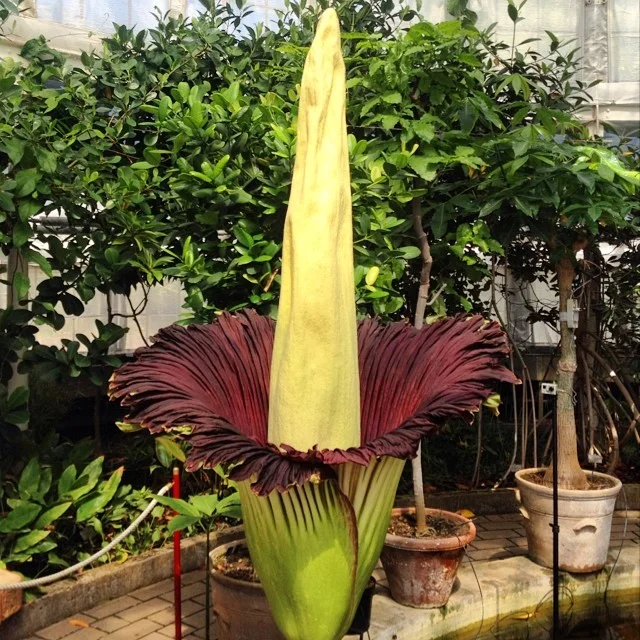Learn about the Penis Flower, also known as Amorphophallus titanum or the Corpse Flower. Discover fascinating facts, growing tips and how to care for this unique and rare plant.
The Amorphophallus titanum, commonly known as the Penis Flower or Corpse Flower, is one of the most fascinating and unusual plants in the world. This guide will explore the unique characteristics of this plant, its lifecycle and how to care for it if you’re lucky enough to encounter one.
Here’s a simple and verified chart for the “Penis Flower,” which is commonly known as Amorphophallus titanum:
| Category | Information |
|---|---|
| Botanical Name | Amorphophallus titanum |
| Common Name | Titan Arum, Corpse Flower, Penis Flower |
| Plant Name | Titan Arum |
| Zone | 9-11 (USDA Hardiness Zones) |
| Sun Exposure | Partial Shade to Full Shade |
| Soil Type | Well-draining, rich, organic soil |
| Watering | Regular, keep soil moist but not waterlogged |
| Growth Habit | Herbaceous perennial, large single bloom |
| Height/Spread | Height: 6-10 feet (1.8-3 m); Spread: 3-5 feet (0.9-1.5 m) |
| Special Features | Known for its enormous, foul-smelling bloom; infrequent flowering (every 3-5 years) |
What is the Penis Flower?

The Amorphophallus titanum, or Penis Flower, is a species of flowering plant native to the rainforests of Sumatra, Indonesia. It’s known for its:
- Enormous size: It produces one of the largest unbranched inflorescences in the world
- Phallic shape: The spadix (central spike) can grow up to 3 meters tall
- Foul odor: When in bloom, it emits a smell similar to rotting flesh
This plant is also called:
- Corpse Flower
- Titan Arum
- Bunga Bangkai (in Indonesian, meaning “corpse flower”)
Fascinating Facts About the Penis Flower
- Rare blooming: The plant only blooms once every 7-10 years in the wild and even less frequently in cultivation.
- Short-lived bloom: The flower only stays open for 24-48 hours.
- Heat production: During blooming, the spadix can heat up to human body temperature to help disperse its scent.
- World’s largest unbranched inflorescence: The largest recorded bloom was 3.10 meters tall.
- Endangered species: Due to deforestation, it’s considered a vulnerable species in its native habitat.
The Lifecycle of Amorphophallus Titanum
Understanding the lifecycle of this unique plant is crucial for its care:
- Dormancy: The plant spends most of its life as an underground corm (similar to a bulb).
- Leaf phase: It produces a single, large, tree-like leaf that can reach up to 6 meters tall.
- Dormancy again: After about 12-18 months, the leaf dies back and the plant goes dormant.
- Flowering phase: After several cycles of leaf growth and dormancy, the plant may produce a flower.
- Fruiting: If pollinated, the plant produces bright red fruits.
How to Grow and Care for a Penis Flower
While it’s challenging to grow Amorphophallus titanum outside of its native habitat or specialized botanical gardens, here are some general care tips:
Light and Temperature
- Prefers bright, indirect light
- Requires warm temperatures (70-80°F or 21-27°C)
- High humidity (70-80%) is essential
Soil and Watering
- Use a well-draining potting mix rich in organic matter
- Keep soil consistently moist but not waterlogged
- Reduce watering during dormancy
Fertilizing
- Feed regularly during the growing season with a balanced, water-soluble fertilizer
- Stop fertilizing when the plant enters dormancy
Repotting
- Repot every few years as the corm grows
- Use a pot that allows for at least 2 inches of soil around the corm
Challenges in Growing Amorphophallus Titanum
Growing this plant comes with several challenges:
- Size: At maturity, it requires a large space
- Dormancy periods: The plant may appear dead for months
- Specialized care: It needs precise environmental conditions
- Rarity: Seeds and corms are difficult to obtain
The Penis Flower in Culture and Conservation
The Amorphophallus titanum has captured public imagination due to its size, shape and smell. It’s often a star attraction at botanical gardens when it blooms.
Conservation efforts are ongoing to protect this species in its native habitat. Botanic Gardens Conservation International leads efforts to conserve this and other rare plant species.
Ethical Considerations
If you’re interested in this plant, consider:
- Supporting conservation efforts rather than trying to obtain a plant
- Visiting botanical gardens to see specimens in bloom
- Learning about and supporting rainforest conservation
Similar Plants
If you’re fascinated by unusual plants like the Penis Flower, you might also be interested in:
- Rafflesia arnoldii: Another “corpse flower” known for its large blooms
- Amorphophallus konjac: A smaller relative of A. titanum
- Dracunculus vulgaris: Also known as the Dragon Arum, with a similar appearance and smell
The Amorphophallus titanum, or Penis Flower, is truly one of nature’s most remarkable creations. Its enormous size, unusual appearance, and powerful scent make it a subject of fascination for botanists and plant enthusiasts worldwide.
While it’s not a plant that most people can grow at home, learning about the Penis Flower can deepen our appreciation for the diversity of plant life. It also highlights the importance of conservation efforts to protect rare and unusual species.
Whether you’re a serious plant collector or simply curious about unique flora, the Penis Flower offers a glimpse into the strange and wonderful world of tropical plants. By understanding and appreciating such rare species, we can all play a part in ensuring their survival for future generations to marvel at.
For more gardening tips and plant care guides, visit usagardenhub.com.






